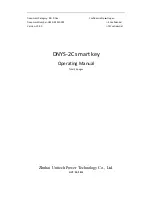
22
E
N
G
L
I
S
H
E X E R C I S E S
Back rest position:
0
With the bench flat, lying on your back, grasp the bar from the cradle. The
handhold must be greater than the width of your shoulders. (Your arms and
forearms must make a 90° angle at mid-movement). Your head should be res-
ting on the bench. Your back should be completely flat. To avoid any arching
of the lumbar vertebrae, you can place your heels on the bench or pull your
knees in close to your chest.
Exercise :
Inhale, while bringing the bar to your chest (without letting it rest
there), then press the bar up smoothly, while exhaling. Your elbows should be
wide apart (your arms and your torso should make a 90° angle).
Muscles worked:
Pectorals, triceps, front of the shoulders.
P E C T O R A L S
D é v e l o p p é c o u c h é ( 1 , 2 , 3 )
Equipment:
BM470. A short dumbbell
Back rest position:
0
Same position as for the bench press. Grasp the short dumbbell with your 2
hands while checking that the iron plates are securely blocked by the collars.
Start with arms semi-extended, dumbbell above the chest.
Exercise :
Inhale, expanding your rib cage, lower your arms behind your
head in such a way as to bring the dumbbell down to bench level. While
exhaling, raise the dumbbell up over the chest. The back should remain abso-
lutely flat and must not arch.
Muscles worked:
Pectorals, triceps, latissimus dorsi muscles.
P u l l o v e r ( 6 , 7 )
Back rest position:
1 or 2
This position also works the pectorals, but particularly the upper section of this
muscle.
Back rest position:
0
Same position as for the bench press. Instead of grasping the bar, take a
short dumbbell in each hand. Start with arms extended (without locking the
elbows) above the chest.
Exercise :
Inhale, open your arms up wide in such a way as to bring your
arms down to the level of your torso. Your elbows should remain slightly bent.
Don’t bring the dumbbells any lower than bench height so as not to strain the
shoulder joints. Then raise the dumbbells back up over your chest as you
exhale.
Muscles worked:
Pectorals, front of the shoulders.
I n c l i n e p r e s s
Back rest position:
-1
Same exercise while lowering the angle of the bench
This position also works the pectorals, but especially the lower part of the
muscle.
D e c l i n e p r e s s
D u m b b e l l p u s h u p ( 4 , 5 )
The basic exercises for harmoniously developing your muscle mass are described here.
D O R S A L S
Back rest position:
0
Position :
Sit facing the pulley tower with your arms holding the T-bar with
a wide grip.
Exercise :
Pull the bar down to the nape of your neck whilst inhaling.
Slowly return to the starting position whilst exhaling, without resting the
weights. Do not pull the bar further down than the nape of your neck.
Muscles worked:
latissimus dorsi, back of shoulders.
B e h i n d n e c k p u l l - d o w n s ( 8 )
C h e s t p u l l s ( 9 )
S H O U L D E R S
Back rest position:
0
Exercise :
Hold the bar with a grip wider than the width of your shoulders.
Bring the bar down behind your neck whilst inhaling. Breath out whilst
pushing the bar above your head, tensing your arms without completely loc-
king your elbows.
Muscles worked:
Outer deltoids
N e c k d e v e l o p m e n t ( 1 0 , 1 1 )
Position :
Same exercise as Behind Neck Pull-downs, but instead you pull
the bar down to the base of the front of the neck. You can use a large or nar-
row grip, palms facing up or down.
Exercise :
Keep your back straight whilst doing this exercise. Your back
should not move backward or forward during this exercise.
Muscles worked:
latissimus dorsi, back of shoulders.
BM 470 notice XP7.QXD:BM 450 russe.QXD 9/05/07 10:16 Page 22


































